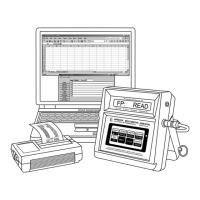ADM-870C 07/14/0927
3. Calculate the effective average face velocity (fpm) by dividing the actual air flow measured in Step #2 (cfm)
by the gross active face area (sq ft) calculated in Step #1.
4. Measure the average face velocity at the AMD using the VelGrid, AirFoil probe or other velocity instrument
being tested for a Kv. Document the procedure used to obtain the average face velocity including all factors
such as: the instrument used, the sensing probe positions, spacing of the velocity sample points and the
number of readings taken to obtain the average for each measurement location. Always record the instrument
type and any specific set up conditions such as whether readings were taken in local or standard air density,
and whether or not the correction included temperature.
5. Calculate the velocity correction factor "Kv" for this particular AMD by dividing the effective average velocity
obtained in Step #3 above by the measured velocity obtained in Step #4 above. This "Kv" factor should now
be used routinely as a required multiplier to correct velocity readings taken at this specific AMD design, model
and size. The specific procedures developed for measuring air velocities at a given AMD must always be used
to obtain the air velocity measurements.
This "demanding" five step procedure seems to leave little room for the "art" of Testing and Balancing. This is not altogether
true. The measurement of the air velocity in Step #4 is affected by the position and orientation of the air velocity measuring
probe. By selective experimental positioning of the sampling point locations, a procedure can be developed which will result
in a Kv for this particular AMD very near or equal to 1.0.
The face velocity test procedure should be included in the AMD test report. The result is a documented, repeatable face
velocity measurement that can be confirmed by a trained technician using the proper instrumentation and following the test
procedure. This procedure may also be used by laboratory personnel to retest the air flow at periodic intervals to confirm
that the flow still conforms to test report data.
6.2 PITOT TUBE VELOCITY MEASUREMENT
The pitot tube is primarily used to obtain air velocity measurements in ductwork. A pitot tube is stainless steel with a 90
degree bend at one end and two connectors at a 90 degree angle located near the base. The measurement range of the
AirData Multimeter with the Dwyer Series 160 standard pitot tube is 25 to 29,000 fpm (calibration accuracy is certified from
50 to 8,000 fpm). A "traverse" of the duct is obtained by taking multiple air velocity readings at equal area locations within
the duct cross-section. See AIR BALANCE MANUALS AND TRAINING PROGRAMS for sources of detailed information
on performing duct traverses and other air balance procedures. The stainless steel pitot tube included in the AirData
Multimeter kit is suitable for use in temperatures up to 1500
/ F.
If the hoses are connected incorrectly, the readings will show as negative air velocity and the meter will display "NEG
PITOT". All passages and connections must be dry, clean, and free of leaks, sharp bends and other obstructions.
After turning the meter on, press the MODE key until PITOT TUBE is displayed. Use the retractile cord to connect the
TemProbe to the meter. Insert the pitot tube and the TemProbe into 3/8" holes drilled into the side of the duct, being careful
to align the point of the pitot tube so that it is facing directly into the airstream. If the negative (-) connection of the pitot tube
is exactly parallel to the duct, the point of the pitot tube should be facing directly into the airstream. The shaft of the pitot
tube is marked at one inch intervals to make it easier to control the location of the pitot tube within the duct. Press the READ
key to obtain the air velocity measurement.
The accuracy of pitot tube results depends heavily upon uniformity of air flow and completeness of the duct traverse.
Careful technique is critical to good results. Pitot tubes are available in several different sizes and configurations to simplify
different applications which may be encountered.
When a pitot tube is used in internally insulated ducts, small particles of fiberglass may be dislodged and become caught
in the openings of the tube. This will effect the accuracy of the readings and eventually clog the tube. Remove the
connections to the meter and blow compressed air through the bottom of the inside tube to discharge fiberglass particles
from the tip of the pitot tube.
NEG PITOT will be displayed if the pitot tube readings are negative. This will occur if the positive (+) and negative (-) hoses
have been incorrectly connected to the inlet ports of the meter; if the probe has been improperly positioned in the air stream;
or if the pitot tube tip has been placed in an area of flow reversal or eddy. It is common practice, although not a purely
accurate procedure, to consider negative pitot tube readings as zero in the averages of pitot tube traverse readings. If a
memory sequence has been started, a NEG PITOT reading will be stored as zero. This zero will be calculated in the
velocity sum and average, and will be recalled as nns NP 0. A memory sequence cannot be started with a "NEG
PITOT" reading.

